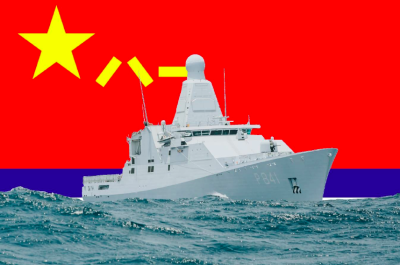China’s PLA Navy

All Global Research articles can be read in 51 languages by activating the “Translate Website” drop down menu on the top banner of our home page (Desktop version).
To receive Global Research’s Daily Newsletter (selected articles), click here.
Visit and follow us on Instagram at @crg_globalresearch.
***
China Wins
It has for a while been discussed that China has the World’s largest navy, with 355 ships.
Chinese navy-vessels are on average smaller in tonnage than the US Navy – so measured in tonnage, the US Navy is for a short while still largest.
This greater US tonnage is largely due to the super-heavy aircraft carriers of the US. China is building her 3rd carrier, the Type 003 which will be around 80% the tonnage of a US carrier, and China is already preparing her 4th carrier Type 004 which will have nuclear propulsion, electric catapults for accelerating the aircraft, and will be fully comparable to the newest and heaviest US carriers.
Aircraft carriers are, however, beginning to look like dinosaurs. Carriers are vulnerable to long range “carrier killer” missiles and instead of carriers, long range aircraft like the Su-35 on distributed bases can do the job. Which is why I propose that a country like India contemplates to not build more carriers and instead invest in super long-range combat aircraft for sea command.
Notably – measured in naval missile tubes, China’s PLA Navy has been referenced to have 90% as many launch tubes as the US Navy. This means, that in stand-off firepower, the surface navies of the two countries are largely equal. This gives China a decisive theatre advantage out to Guam both in naval force and land based Chinese theatre missiles and aircraft launched long-range missiles.
Qualitatively, China is also closing in, but in subsurface warfare the US still has a large lead. Which makes the USS SN-22 “Connecticut incident” more conspicuous, since this is the stealthiest and most advanced US ”Seawolf” attack submarine class, of which even the US only has three. Now, China has probably been able to locate and decapacitate one unit – or one third – of the ”Seawolf” fleet of the most advanced US subs. Really a huge Chinese achievement, if this is the case, which it most likely is.
Even more importantly – China has the World’s largest ship-building output – also in naval vessels.
This is very interestingly confirmed in a report, which states that the PLA Navy will presumably grow to 460 ships in less than 10 years, by 2030.
The US is a loser
Since Obama, the US has feverishly and vainly tried to make up for China’s superior naval program.
First was Obama’s “pivot to Asia” – concentrating a larger percentage of US global navy assets to encircle China around Taiwan and the South China Sea.
Second, and simultaneously, for the past many years, the US has in a frenzy tried to increase the operational tempo and up-time of their US Navy ships – effectively running the US Navy vessels down due to over-use and cut-downs in time for maintenance. We see the result in US Navy accidents.
Thirdly, the US Navy has every year lobbied for building a larger US Navy – the US Navy has hoped for something in about 15 years on the order of 350 US naval ships – which China already has. And in 15 years, China (ref. link above) will have have surpassed the expected 460 ships for 2030.
Fourthly, the US is calling upon its vassals, the UK, France (before the US put dirt on France, like the US often does with even its partners), Australia, and Japan to join the US Navy to encircle China. Each of them only contribute marginally. For instance, the once mighty UK Navy could only contribute with one single feeble mini-carrier, the Queen Elizabeth II with a small contingent of the short-range F-35B. Ridiculous in the long-range theater of the Western Pacific.
The UK even did not have ships enough to supply its own escort fleet for the QE II propaganda-tour to Asia, so the US and even the small Netherlands had to supply escort ships to protect the helpless Queen Elizabeth II. France is the same thing, wanting to patrol both the Indian Ocean and the French colonies in the Pacific with a single French basket-case carrier. Germany sent a frigate to “frighten China” – yes, so low can you go. Australia will only have new submarines in such a long-distant future day that doomsday will be long over. Only Japan is doing something serious, but far from decisive, mostly annoying China.
Fifthly, the US is trying to recruit India. India’s problems with China in the Himalayas is very much due to this, and due to India’s abrogation of Kashmir’s autonomy. India’s problems with China are to a large degree self-made. The US does not care about India’s problems in Himalaya – or about India per se at all. All the US talk about “democracy” is just to please the Indians. For the US, it is all about recruiting the Indian Navy as a subsidiary force into the naval game of the US.
All this maniac US ado is in vain for the US.
The US cannot keep up.
Taiwan will go to Beijing – and US global power will go to the bottom.
*
Note to readers: Please click the share buttons above or below. Follow us on Instagram, @crg_globalresearch. Forward this article to your email lists. Crosspost on your blog site, internet forums. etc.
Karsten Riise is a Master of Science (Econ) from Copenhagen Business School and has a university degree in Spanish Culture and Languages from Copenhagen University. He is the former Senior Vice President Chief Financial Officer (CFO) of Mercedes-Benz in Denmark and Sweden.
Featured image: PLA Navy – Karsten Riise and Stiven Sanchez, Unsplash CC0

